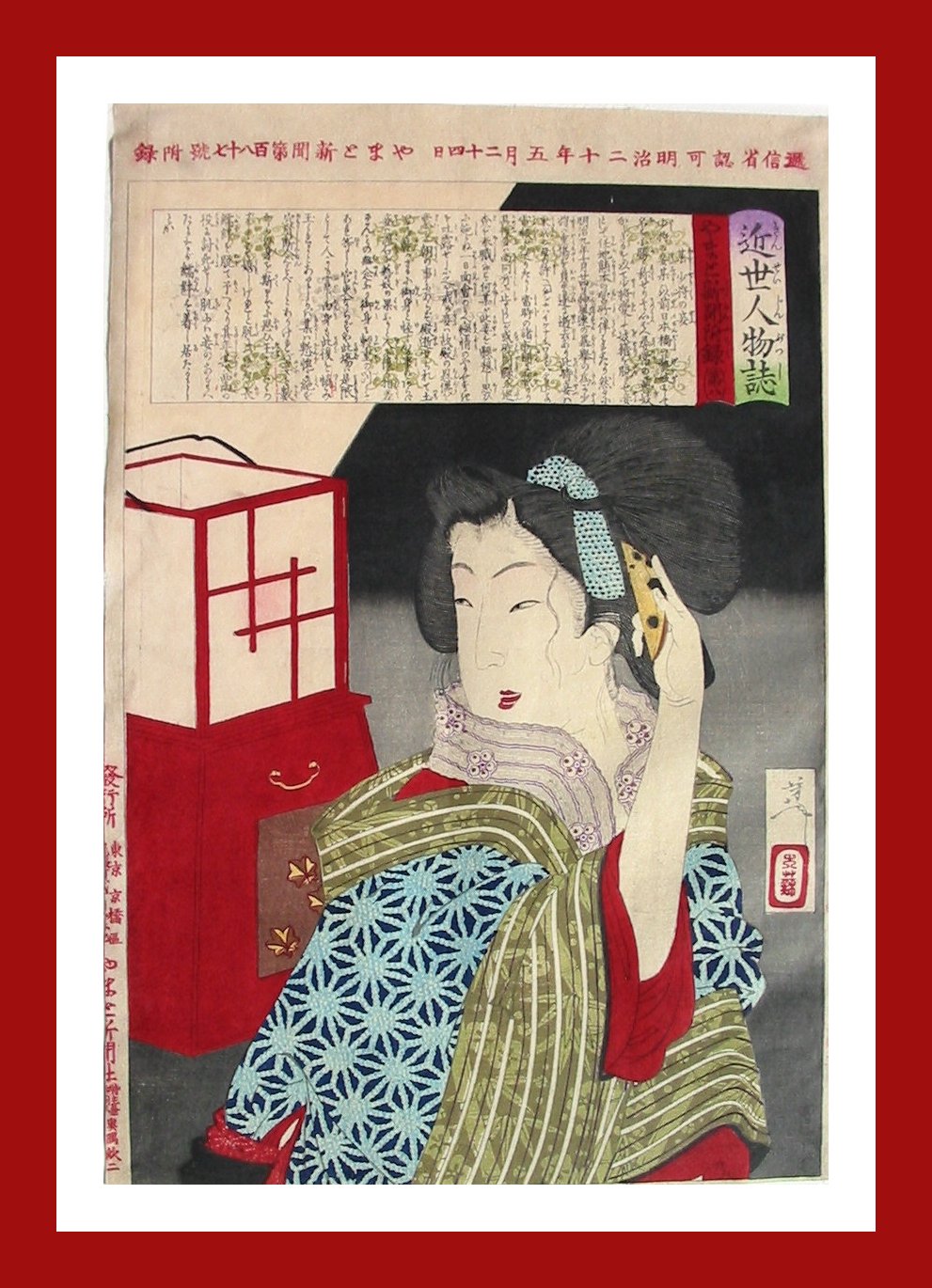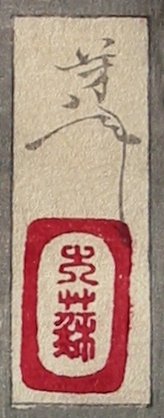
JAPANESE PRINTS
A MILLION QUESTIONS
TWO MILLION MYSTERIES
Ukiyo-e Prints浮世絵版画 |
|
formerly of Port Townsend, Washington now Kansas City, Missouri |
|
TSUKIOKA YOSHITOSHI 1839-1892 |
|
月岡芳年 |
|
つきおかよしとし |
|
Series: Biographies of Modern People |
|
Kinsei Jinbutsu Shi |
|
近世人物誌 |
|
きんせいじんぶつし |
|
Subject: The Geisha Kokatsu |
|
Print Size: 14 1/8" x 9 1/2" |
|
Date: 1887, 5th Month, 24th Day Meiji 20 明治20 |
|
Publisher: Yamato やまと |
|
There are other copies of this print in the collection of Waseda University,
the Tokyo
Metropolitan Library and
|
|
SOLD! |
|
|
|
|
|
|
|
|
|
|
|
|
|
|
|
|
|
|
|
|
|
|
|
|
|
Kinsei Jinbutsu Shi 近世人物誌 きんせい.じんぶつ.し |
|
|
|
|
|
|
|
|
Meiji 20, 5th Month, 24th Day (Read right to left at the top of the print.) |
|
|
|
LUDDITES AND WOUNDED KNEE |
|
Several years ago I took a two month camping trip. On the way home I stopped at Wounded Knee on the Pine Ridge Reservation. Not only was the site powerful for its setting, but also for its poignancy. A large bronze plaque described the massacre which included a group of young men who believed that their magic made them invisible to the enemy and impervious to their bullets. Needless to say, many if not all of them died as a result of their self-deception. They had no real grasp of the nature of the forces that opposed them.
In 1811 and 1812 a group of men in England, who came to be known as Luddites, destroyed a lot of machinery which they felt endangered their livelihoods and hence they ways of life. These men became the primary symbols in the West of reactionism. I still have friends who don't own a television or a computer and who obviously can't send e-mail. They are definitely resistant to trends in technology even though they fly all over the world, ride in cars and take elevators to their luxury suites on the 23rd floor. I guess each of us gets to pick and choose.
************
The print on this page is a portrait of the geisha Kokatsu who was the mistress of one of the Meiji commanders of a garrison at Kumamoto (熊本 or くまもと). The year was 1876, almost 9 years since the beginning of the Meiji Restoration, and discontent among the old order, i.e., the samurai class, was festering. On the night of October 24th rebels known as the Shinpūren divided into two main groups and made a coordinated sneak attack. One part surprised the garrison and slaughtered many of the soldiers showing no mercy for those who were wounded or captured. The other group attacked the telegraph office and destroyed the machinery which was so symbolic of all the things they hated. "Still others attacked the residences of the prefectural governor Yasuoka Ryōsuke, the garrison commandant Major Taneda Masaaki, and the chief of staff Lieutenant Colonel Takashima Shigenori. They killed Taneda and Takashima, mortally wounded Yasuoka, and burned down his house."* After telegraph communications were reestablished Taneda's mistress, the geisha Kokatsu, telegraphed the news to her parents.
The emasculated samurai class resented everything Western and everything modern. As a result the attackers demurred the use of modern weaponry preferring their traditional swords. This was fine in the opening assault, but in the end served them no better than the delusional Sioux warriors at Wounded Knee. Also, by destroying the telegraph equipment the Shinpūren cut off their best source for quick communications which could summon support for reinforcements. The similarities to attitudes both Eastern and Western are striking. |
|
*This quote is from Emperor of Japan: Meiji and His World, 1852-1912 by Donald Keene (pages 264-66). For students of Japanese history or culture I can't recommend this book enough. It should be a well-used addition to your personal library. |
|
|
This text indicates that this is a newspaper supplement: |
|
|
|
|
|
|
|
yamato shinbun furoku やまと新聞付録 |
|
|
|
|
|
|
|
This text reads: |
|
|
某(なにがし) 少将(せうせう)の妾(せふ)
|
||





 HOME
HOME